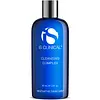What's inside
What's inside
 Key Ingredients
Key Ingredients

 Benefits
Benefits

 Concerns
Concerns

 Ingredients Side-by-side
Ingredients Side-by-side

Water
Skin ConditioningDisodium Laureth Sulfosuccinate
CleansingCocamidopropyl Betaine
CleansingPEG-30 Glyceryl Cocoate
EmulsifyingGlycerin
HumectantPropylene Glycol
HumectantHydroxyethylcellulose
Emulsion StabilisingSalix Alba Bark Extract
AstringentSaccharum Officinarum Extract
MoisturisingCamellia Sinensis Leaf Extract
AntimicrobialChamomilla Recutita Flower Extract
MaskingAsiaticoside
AntioxidantAsiatic Acid
Skin ConditioningMadecassic Acid
Skin ConditioningAscorbyl Palmitate
AntioxidantPhospholipids
Skin ConditioningTocopheryl Acetate
AntioxidantRetinyl Palmitate
Skin ConditioningIodopropynyl Butylcarbamate
PreservativePhenoxyethanol
PreservativeWater, Disodium Laureth Sulfosuccinate, Cocamidopropyl Betaine, PEG-30 Glyceryl Cocoate, Glycerin, Propylene Glycol, Hydroxyethylcellulose, Salix Alba Bark Extract, Saccharum Officinarum Extract, Camellia Sinensis Leaf Extract, Chamomilla Recutita Flower Extract, Asiaticoside, Asiatic Acid, Madecassic Acid, Ascorbyl Palmitate, Phospholipids, Tocopheryl Acetate, Retinyl Palmitate, Iodopropynyl Butylcarbamate, Phenoxyethanol
Water
Skin ConditioningGlycerin
HumectantSodium Stearate
CleansingSodium Cocoyl Isethionate
CleansingMyristic Acid
CleansingPropanediol
SolventPalmitic Acid
EmollientCaprylic/Capric Triglyceride
MaskingCellulose Acetate
Polyglyceryl-10 Laurate
Skin ConditioningStearic Acid
CleansingGlyceryl Behenate
EmollientHydrogenated Jojoba Oil
AbrasiveCopernicia Cerifera Wax
Polyglyceryl-2 Stearate
EmulsifyingAlanine
MaskingArginine
MaskingCeramide Ng
Skin ConditioningThreonine
Salicylic Acid
MaskingNiacinamide
SmoothingHydrolyzed Hyaluronic Acid
HumectantLysine Hcl
Skin ConditioningGlycine
BufferingProline
Skin ConditioningSerine
MaskingGlutamic Acid
HumectantVitis Vinifera Seed Oil
EmollientChamaecyparis Obtusa Leaf Extract
Skin ConditioningCitrus Unshiu Fruit Extract
AntioxidantGlycyrrhiza Glabra Root Extract
BleachingLactobacillus Ferment
Skin ConditioningBetaine
HumectantDextrin
AbsorbentPCA
HumectantPolydextrose
HumectantSodium Lactate
BufferingCaprylhydroxamic Acid
Sodium PCA
HumectantAmylopectin
Benzyl Alcohol
PerfumingTrisodium Ethylenediamine Disuccinate
Lauric Acid
CleansingCoconut Acid
CleansingSodium Isethionate
CleansingWater, Glycerin, Sodium Stearate, Sodium Cocoyl Isethionate, Myristic Acid, Propanediol, Palmitic Acid, Caprylic/Capric Triglyceride, Cellulose Acetate, Polyglyceryl-10 Laurate, Stearic Acid, Glyceryl Behenate, Hydrogenated Jojoba Oil, Copernicia Cerifera Wax, Polyglyceryl-2 Stearate, Alanine, Arginine, Ceramide Ng, Threonine, Salicylic Acid, Niacinamide, Hydrolyzed Hyaluronic Acid, Lysine Hcl, Glycine, Proline, Serine, Glutamic Acid, Vitis Vinifera Seed Oil, Chamaecyparis Obtusa Leaf Extract, Citrus Unshiu Fruit Extract, Glycyrrhiza Glabra Root Extract, Lactobacillus Ferment, Betaine, Dextrin, PCA, Polydextrose, Sodium Lactate, Caprylhydroxamic Acid, Sodium PCA, Amylopectin, Benzyl Alcohol, Trisodium Ethylenediamine Disuccinate, Lauric Acid, Coconut Acid, Sodium Isethionate
 Reviews
Reviews

Ingredients Explained
These ingredients are found in both products.
Ingredients higher up in an ingredient list are typically present in a larger amount.
Glycerin is already naturally found in your skin. It helps moisturize and protect your skin.
A study from 2016 found glycerin to be more effective as a humectant than AHAs and hyaluronic acid.
As a humectant, it helps the skin stay hydrated by pulling moisture to your skin. The low molecular weight of glycerin allows it to pull moisture into the deeper layers of your skin.
Hydrated skin improves your skin barrier; Your skin barrier helps protect against irritants and bacteria.
Glycerin has also been found to have antimicrobial and antiviral properties. Due to these properties, glycerin is often used in wound and burn treatments.
In cosmetics, glycerin is usually derived from plants such as soybean or palm. However, it can also be sourced from animals, such as tallow or animal fat.
This ingredient is organic, colorless, odorless, and non-toxic.
Glycerin is the name for this ingredient in American English. British English uses Glycerol/Glycerine.
Learn more about GlycerinWater. It's the most common cosmetic ingredient of all. You'll usually see it at the top of ingredient lists, meaning that it makes up the largest part of the product.
So why is it so popular? Water most often acts as a solvent - this means that it helps dissolve other ingredients into the formulation.
You'll also recognize water as that liquid we all need to stay alive. If you see this, drink a glass of water. Stay hydrated!
Learn more about Water